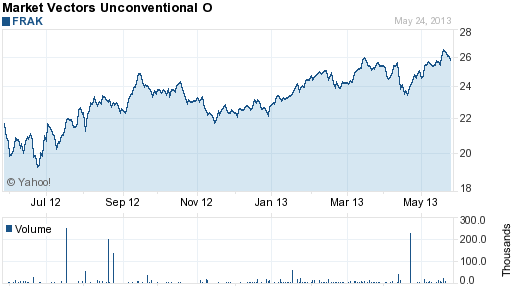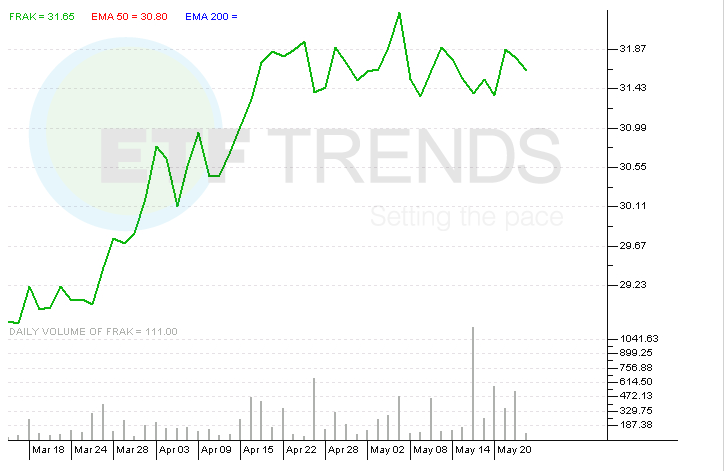Unconventional Oil And Gas ETF – What You Need To Know
Post on: 5 Май, 2015 No Comment

Many investors are seeking the ability to add commodity exposure to their portfolios. This can be difficult for most home-based investors to achieve through traditional methods. Since the advent of exchange-traded funds, anyone with a brokerage account can now easily jump into the commodities market. When it comes to trading commodities, there isn’t an easier method than by utilizing commodity ETFs .
Why Invest in Unconventional Oil and Gas?
The traditional methods for obtaining oil have long produced large quantities at relatively low costs. But with the rising price of oil and its by-products, many exploration companies are delving into unconventional methods for extracting oil and natural gas products from the earth. Known in the industry as ‘fracking,’ hydraulic fracturing is a method for recovering hydrocarbon deposits from the ground. This method is used to extract coalbed methane, shale oil, shale gas, coal seam gas, tight natural gas, and tight oil sands.
As stated above, with the rising price of oil, there has been an increase in incentive for companies to develop technologies to extract these resources. Advancements in horizontal drilling and hydraulic fracturing have made it easier and more cost efficient to recover deposits of hydrocarbons. This recent boom in unconventional oil and gas exploration has occurred in North and South America, as well as in Europe and Asia, partly as a way for countries to become more independent from Middle Eastern oil, and also as a way to boost exports. This is particularly true for countries that are in need of an economic boost.
This segment of resource commodities is relatively untouched, as the technology is brand new and companies are just starting to jump into this segment. But it doesn’t come without risk. There are basically two risks associated with this investment:
Environmental concerns
Because fracking and horizontal mining is new technology, there isn’t a lot of published data on the effects that these methods have on the health of the environment, and particularly ground water. There is mounting concern that these mining techniques leach harmful chemicals into the ground water, rendering it undrinkable. Activists consider these techniques ‘strip mining,’ and portray them as a sort of scorched earth. This bad press, along with possible future regulations by the EPA or other government agencies around the world, has the potential to stop unconventional oil and gas exploration and mining in its tracks.
Oil price
Because the technology and techniques involved in fracking are new and expensive, the price of oil needs to remain high for there to be enough payoff for going after those reserves. As long as oil commodities prices remain high, the risk remains minimal. Keep in mind that oil price depends on global supply and demand, and for the foreseeable future, demand will continue to rise. Future developments in alternative energy could play a role in diminishing that demand, but have yet to make any significant breakthroughs.
How to Trade Unconventional Oil and Gas
There are basically two methods for investing in unconventional oil and gas commodities:
The best way to invest directly in unconventional oil and gas is to utilize ETFs that track an index, oil and gas contract futures, or physical oil and gas holdings. This is what commodities investing is all about. Unfortunately, once the commodity has reached the market, there is no difference from oil harvested by an unconventional method versus conventional drilling, so you will track the price of oil or natural gas. Investing indirectly in unconventional oil and gas commodities involves either investing directly in equities of companies that deal with these commodities, or by utilizing ETFs that buy equity in those same companies. Since the revenues of these companies are directly related to the price of shale oil, shale gas, coalbed methane, and other unconventional oil and gas commodities, it is a good way to indirectly ‘hold’ these commodities.
Since this is an article about ETFs, we will focus on a direct and an indirect ETF option for unconventional oil and gas investing.
Unconventional Oil and Gas ETF List of Options
Direct
IQ Global Oil Small Cap ETF (IOIL)
IOIL, founded in 2011, is a global small cap oil production and exploration focused ETF. IOIL tracks the price and yield performance of the IQ Global Oil Small Cap Index. The underlying index is a rules based, modified capitalization weighted, float adjusted index intended to give investors a means of tracking the overall performance of the global, small capitalization sector of publicly traded companies that are engaged primarily in the oil sector.
IOIL provides exposure to global small cap companies engaged in the areas of exploration and production, refining and marketing, and equipment, services and drilling. IOIL holds equity in approximately 60 securities, with exposure split between US and international securities. IOIL is comprised mostly of refining and marketing companies. Exploration and equipment firms come in second. When looking at individual securities held by IOIL, the Dutch company Core Laboratories (CLB) is the number 1 held security, followed by Oceaneering International (OII) and HollyFrontier (HFC).

Indirect
Market Vectors Unconventional Oil & Gas ETF (FRAK)
Founded in February of 2012, FRAK is so far the only ETF option that specifically targets the unconventional oil and gas industry. FRAK tracks the price and yield performance of the fund (the ‘index’). FRAK invests at least 80% of its total assets in securities that comprise the fund’s benchmark index. The index is comprised of securities of companies involved in the exploration, development, extraction, production and/or refining of unconventional oil and natural gas. The index contains companies that generate at least 50% of their revenues from unconventional oil and gas or that own properties with the potential to generate at least 50% of their revenues from this segment.
FRAK holds 43 securities, including Canadian Natural Resources LTD (CNQ) as its top holding, followed by Occidental Petroleum Corp (OXY) and EOG Resources Inc (EOG). The variety of companies that FRAK holds adds diversity and limits the risks talked about above.
In Conclusion
Adding commodity exposure to your portfolio through ETF investing is a great way to add diversity, as well as inflation protection. With the many advantages of ETF trading (intraday investing, low cost, transparency of assets), you can increase your bottom line with respects to investment results.
Unconventional oil and gas ETF investing is an intriguing option for commodities investors. With the creation of FRAK, the first ETF in this sector of natural resources, investors now have the ability to gain exposure in this new and quickly developing field. If you are looking to add a different kind of oil and gas exposure to your portfolio, FRAK is a good way to go.
Disclosure
I have no positions in any ETFs or ETNs mentioned, and no plans to initiate any positions within the next 72 hours.
Disclaimer: Please remember to do your own research prior to making any investment decisions. This article is not a recommendation to buy or sell any securities or stocks, and is the opinion of the author.














